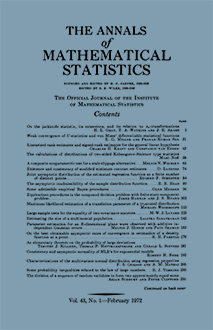Abstract
This paper discusses the use of order statistics in estimating the parameters of (negative) exponential populations. For the one-parameter exponential population, the best linear unbiased estimators, $\tilde \sigma_k = c_kx_k$ and $\tilde \sigma_{lm} = c_lm_l + c_mx_m$, of the parameter $\sigma$ are given, based on one order statistic $x_k$ and on two order statistics $x_l$ and $x_m$. For samples of any size up through $n = 100$, a table is given of $k, l$, and $m$ and of the coefficients $c_k, c_l$, and $c_m$, together with the coefficients of $\sigma^2$ in the variances $V_k$ and $V_{lm}$ of the estimators, and the corresponding efficiencies $E_k$ and $E_{lm}$ (relative to the best linear unbiased estimator based on all order statistics). For the two-parameter exponential population, the best linear unbiased estimators, $\tilde \alpha = c_{\alpha l}x_l + c_{\alpha m}x_m, \tilde \sigma = c_{\sigma l}x_l + c_{\sigma m}x_m$, and $\tilde \mu = c_{\mu l}x_l + c_{\mu m}x_m$, of the parameters $\alpha$ and $\sigma$ and the mean $\mu = \alpha + \sigma$ are given, based on two order statistics $x_l$ and $x_m$. For samples of any size up through $n = 100$, a table is given of $m(l$ is always 1 for the best estimator) and of factors $c_\alpha$ and $c_\alpha$ for computing the coefficients $c_{\alpha l} = 1 + c_\alpha, c_{\alpha m} = -c_\alpha, c_{\sigma l} = -c_\sigma, c_{\sigma m} = c_\sigma, c_{\mu l} = 1 + c_\alpha - c_\sigma$, and $C_{\mu m} = C_\sigma - C_\alpha$, together with the coefficients of $\sigma^2$ in the variances $V_{\tilde \alpha}, V_{\tilde \sigma}$, and $V_\mu$ of the estimators, and the corresponding efficiencies $E_{\tilde \alpha}, E_{\tilde \sigma}$, and $E_{\tilde \mu}$ (relative to the best linear unbiased estimators based on all order statistics).
Citation
H. Leon Harter. "Estimating the Parameters of Negative Exponential Populations from One or Two Order Statistics." Ann. Math. Statist. 32 (4) 1078 - 1090, December, 1961. https://doi.org/10.1214/aoms/1177704847
Information





